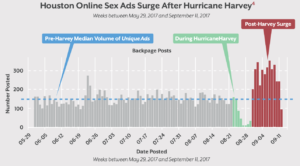Cascading Effects: The Relationship Between Natural Disasters, Armed Conflict, Forced Migration, and Human Trafficking by Benjamin Thomas Greer
Human traffickers will capitalize on the vulnerability of disaster events to exploit victims. In disasters, traffickers see opportunity.
Natural and man-made disasters wreak havoc on economic, political, and geographical landscapes. Humanitarian crises such as hurricanes, earthquakes, and war, exacerbate pre-existing vulnerabilities conducive to exploitation of those affected. With the sudden introduction of economic and security instability, loss of employment, and the rapid deterioration of living conditions disaster events create, traffickers may seek to profit from an environment ripe for exploitation.
While not all victims of disasters inherently become trafficking victims, the common risk factors of being trafficked are present in disaster event refugees. Economic pressure, political instability, and social and cultural factors coupled with criminal greed are known as root causes of the trafficking experience. In the wake of Hurricane Harvey, the U.S. Department of Health and Human Services began identifying emergency management personnel as uniquely positioned to identify and report potential human trafficking and related suspicious behavior. Emergency management agencies should design their response and recovery programs to prevent reasonably foreseeable victimization.
Human trafficking is best described as the exploitation of others for profit through the use of force, fraud, or coercion. This pernicious act decimates the lives of the trafficked, fracturing families, and exploits the victim’s body and labor as a renewable resource. Ever the opportunists, traffickers may seek to exploit victims through commercial sexual exploitation, labor trafficking or profit from the unwitting government contract process.
Traffickers seek out vulnerable populations, typically using techniques of physical and psychological abuse – utilizing fear and intimidation to exert control over their victims. Some traffickers may utilize physical restraints, while others use less obvious methods, specifically debt bondage – asserting erroneous financial obligations wherein the victim feels honor-bound to satisfy a dubious debt.
Tied with illegal arms sales, human trafficking is commonly seen as the second largest criminal activity in the world and one of the fastest growing criminal activities. The International Labour Organization estimates trafficking generates upwards of $150 billion a year. With the complexities of the world increasing, the relationships between disaster events, forced migration, and human trafficking will continue.

Forced/Exploited Labor – Exploitation of Workers Post-Hurricane Katrina (2005)
The United States has a series of procedural safeguards to inhibit exploitation of labor; however, these prophylactics are not effective if they are not enforced. One of these tools is the Davis-Bacon Act (DBA). The DBA applies to federal contracts in excess of $2,000 for the repair, alteration, or construction of public works/public buildings. It requires contractors to pay their workers no less than the locally prevailing wages.
The other procedural safeguard is proof of worker’s eligibility (either proof of citizenship or legally permitted to work in the U.S.). These two laws work in a symbiotic relationship, to ensure taxpayer funds are supporting legitimate work while providing stable and livable wages. Without one, or both of these tools, exploitation is more likely to occur.
After Hurricane Katrina’s landfall, the region was structurally, economically, and emotionally decimated. To increase the pace of recovery, President Bush suspended the DBA. It was done with the intent to remove “bureaucratic” paperwork, seen to slow recovery efforts. However, removal of these requirements disincentivized sourcing local workers while attracting migrant workers accustomed to much lower wages.
Signal International, a marine construction firm specializing in the repair of offshore drilling rigs, saw their workforce depleted. Recruiting agents for Signal fraudulently induced and coerced nearly 500 guestworkers from India. Once employed the workers were subjected to living in labor camps under insalubrious conditions while suffering psychological abuse and being defrauded of their hard-earned wages. The fraudulent inducement consisted of false promises of citizenship and significantly higher wages. Upon arrival, recruiting agents confiscated visas/passports, coerced workers to pay exorbitant fees to cover their recruitment, travel, and immigration processing, and threatened them with physical harm and legal actions unless they continued working. A jury found Signal liable for labor trafficking, racketeering, and discrimination.
Sexual Exploitation Spike –
Hurricane Harvey (2005)
Most emergency management professionals are familiar with the disaster life cycle: hazard mitigation, preparedness, response, and recovery. A failure within this cycle could increase potential harm, destruction of property, and could slow or inhibit recovery. Failing to understand or identify likely hazards makes crafting an effective mitigation plan almost impossible.
Most emergency planners fail to fully appreciate how an exploiter will seek to leverage a disaster for profit. Learning from Hurricane Katrina, the city of Houston designed an aggressive post-disaster anti-trafficking public awareness campaign. Utilizing the 12-years of knowledge gained between Hurricanes Katrina and Harvey, the city of Houston was better prepared to counter exploitation within their city.
As shelters opened, the mayor’s office and the Houston Human Trafficking Task Force had representatives providing in-person education and outreach regarding the vulnerability to trafficking. This large-scale operation reached over 4,000 individuals. Post-Hurricane Harvey, the Houston area witnessed a precipitous decline in online sex advertisements, followed by an exponential surge after the storm subsided. While causation may be debated, the city’s foresight and proactive measures were prescient.
Disaster Responders are Uniquely Positioned to Identify, Interdict, and Mitigate Exploitation
Emergency response units occupy real estate at a critical juncture of public health/safety and homeland security. Disaster responders are remarkably well-positioned to interact and support many of these vulnerable populations. Often these response units are comprised of civilian members of a Community Emergency Response Team (CERT). Their emergency access provides them unique admittance to environments which would be otherwise inaccessible to law enforcement or social services.
Emergency response personnel enjoy a level of trust law enforcement generally does not. The public receives them as helpers and not incarcerators. This social equity allows them a level of disclosure police and federal agencies do not enjoy. In keeping with the duty and obligation to protect vulnerable populations, these emergency responders should be knowledgeable on ancillary predatory behavior they are likely to encounter, including trafficking.


Conclusion
Research indicates the most effective response curbing trafficking is a comprehensive and holistic approach. A comprehensive and holistic anti-trafficking approach should enhance not only statutory penalties but also include mitigation programs. Currently, emergency and disaster responders are woefully undertrained and under skilled to properly identify suspicious behavior.
State and Federal emergency management agencies must plan for and design an anti-trafficking hazard mitigation plan. This need becomes more pressing as state and federal agencies prepare to receive refugees escaping war, climate change, and disasters. As this body of research develops, agencies and their non-governmental partners must study, plan and anticipate this threat nexus.
As the climate continues to change, military conflicts erupt, exacerbating vulnerabilities in our communities, our response structure needs to evolve to address anticipated threats. With increased insight into the nexus between natural disasters and exploitation emergency management, agencies must update their response. Expanding and refining our awareness and identification protocols will remove the shadow traffickers require to operate. ❦

About the Author
Benjamin Thomas Greer, J.D., M.A. Benjamin.Greer@caloes.ca.gov
Emergency Management Instructor, California Governor’s Office of Emergency Services (CalOES); Research Associate for the University of Cambridge’s Centre for Applied Research in Human Trafficking (CCARHT); Master’s Degree from Naval Postgraduate School’s Center for Homeland Defense and Security Program (NPS-CHDS).
